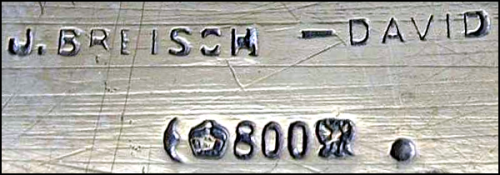|
english deutsch
Silber800.de – Bruckmann & Söhne: Hallmarks |
||||||
| Home | Designs | Designers | Hallmarks | Books | My Collection | Third Reich |
|
In 1884 a law was enacted making .800 the minimum national standard for silver in Germany. In 1886 the use of individual city marks was abolished and replaced by the national mark (reichsmark) of a crescent moon, and crown mark (Halbmond und Krone), together representing the entire German state. By 1888 these marks became compulsory.
The crescent moon and crown are used in conjunction with a decimal silver standard mark and a maker`s mark. Common silver standards are .800 and .835. Other purities also used are .830, .900, .925 and .935. Why do some items have the retailer name but not others? And at what point in time would the retailer's name have been added - at manufacture time or later?The retailer's mark was either punched by the manufacturer, shortly after he made the pieces, or by the retailer (with the manufacturer's consent), after he received the pieces. There is no pattern as to who did it when. It was the retailer's choice to punch it with his own name (or not). If punched, he could and would claim that he also was the maker (thus misleading his clients). c.f. Bahner, www.925-1000.com
|




















